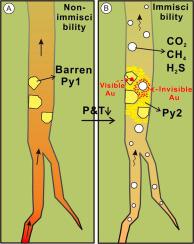Ore Geology Reviews ( IF 3.2 ) Pub Date : 2023-03-13 , DOI: 10.1016/j.oregeorev.2023.105387 Zheng Liu , Pei Ni , Guo-Guang Wang , Yue-Qiao Zhang , Zhong-Lie Sheng , Shun-Lin Zhang , Ming-Sen Fan , Zi-Hao Zhao

|
Pyrite, as one of the most important Au carriers, can well document ore-forming processes. In this study, we select the Hekou gold deposit (HKGD), a newly discovered deposit in the North China Craton (NCC), to rebuild its ore-forming process and gold precipitation mechanism with pyrite. The gold-bearing pyrite was used to perform a combined micro-textural petrography, elemental and S isotope analyses. The micro-textural petrography reveals two distinguished generations of pyrite, including coarse-grained euhedral Py1 and fine-grained xenomorphic Py2. The fine-grained xenomorphic Py2 likely results from a fast nuclear rate responding to the rapid thermochemical changes of hydrothermal fluid. Trace elements of pyrite constrained by LA-ICP-MS reveal that the concentrations of metals such as Au, Ag, Cu, and Pb dramatically increase from Py1 to Py2, suggesting that the fluid evolved to oversaturation. The concentrations of As notably decrease from 284.35 to 23.27 ppm from Py1 to Py2, supporting that As escape from the ore solutions. Moreover, the in situ S isotopes by LA-MC-ICP-MS reveal a minor δ34S fractionation between Py1 (6.29±0.22‰, 2SD) and Py2 (5.95±0.22‰, 2SD), which also agree with the isotopic behavior of H2S escape. All of them, together with fluid inclusion observation, we explain that the two-stage pyrite formation in the HKGD records a hydrothermal system evolution from non-immiscibility (Py1) to immiscibility (Py2). Fluid immiscibility likely effectively facilitated the Au precipitation in the HKGD, via significantly destabilizing the Au-HS complex in fluid and incorporating Au into pyrite. Meanwhile, it also led to an unusual decoupling of Au and As in pyrite. This study highlights that the pyrite texture and chemistry can be excellent tools to reveal trace hydrothermal system evolution and gold precipitation mechanism.
中文翻译:

华北克拉通河口金矿热液演化与金沉淀机制:从黄铁矿结构、成分和原位硫同位素的启示
黄铁矿作为最重要的金载体之一,可以很好地记录成矿过程。在本研究中,我们选择华北克拉通 (NCC) 新发现的河口金矿床 (HKGD),用黄铁矿重建其成矿过程和金沉淀机制。含金黄铁矿用于进行微观结构岩相学、元素和 S 同位素分析。微结构岩石学揭示了黄铁矿的两个不同世代,包括粗粒自形 Py1 和细粒异形 Py2。细粒异形 Py2 可能是由于快速核速率响应热液流体的快速热化学变化。LA-ICP-MS 约束的黄铁矿中的痕量元素表明,Au、Ag、Cu 和 Pb 等金属的浓度从 Py1 到 Py2 急剧增加,表明流体演变为过饱和状态。从 Py1 到 Py2,As 的浓度从 284.35 ppm 显着降低到 23.27 ppm,支持 As 从矿石溶液中逸出。此外,LA-MC-ICP-MS原位S 同位素显示Py1 (6.29±0.22‰, 2SD) 和 Py2 (5.95±0.22‰, 2SD) 之间存在较小的δ 34 S 分馏,这也与 H 2的同位素行为一致逃脱。所有这些,连同流体包裹体观察,我们解释了 HKGD 中的两阶段黄铁矿形成记录了从非混相(Py1)到不混相(Py2)的热液系统演化。流体不混溶性可能通过显着破坏流体中的 Au-HS 络合物并将 Au 结合到黄铁矿中,从而有效地促进了 HKGD 中的 Au 沉淀。同时,它还导致了黄铁矿中 Au 和 As 的异常解耦。这项研究强调,黄铁矿的结构和化学性质可以成为揭示微量热液系统演化和金沉淀机制的极好工具。











































 京公网安备 11010802027423号
京公网安备 11010802027423号